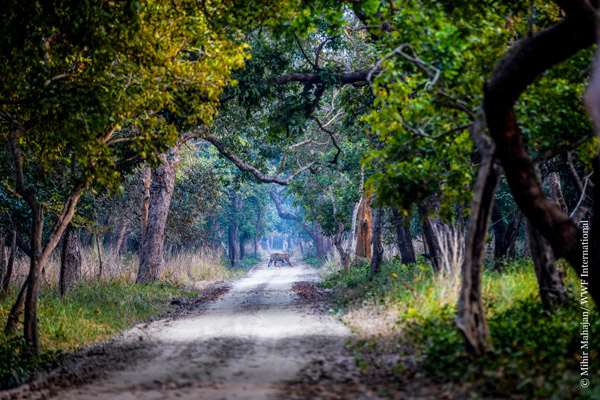What do you see when you think of a tiger?
Dark black stripes with a tawny coloured body, a cultural icon or a symbol of power? A tiger is all of that and so much more. The presence of this elusive big cat impacts even those without a personal connection to them. As a keystone species, without them, entire ecosystems could collapse.
Tigers and their habitats provide vast benefits to the climate, people and wildlife.
Often recognised as charismatic yet ferocious, tigers are one of the most powerful predators.
On Global Tiger Day 2023, let us delve into the fantastic world of these majestic species and see how they help us save so much more.
Tigers and forests are deeply rooted together. They live, breed, and hunt in groves, and as apex predators, these majestic species are a sign of a healthy ecosystem.
Protecting tigers also helps safeguard a range of critically important habitats and ecosystems. Likewise, each hectare protected as a tiger habitat has a multitude of economic benefits.

Two female Bengal tiger cubs playing in the Ranthambore National Park, Rajasthan.
Tiger is the largest cat on earth and is a top predator. It helps check the population of herbivores while maintaining the health of a forest or grassland that they call home. By protecting their kingdoms, we are securing the future for other wildlife!

Tigers walking at night in the Tadoba Andhari Tiger Reserve, Maharashtra.
For centuries, tigers are symbolically embedded in the Indian culture. From ancient folklore, children’s books to scriptures, this feline has been largely depicted in our culture since time immemorial.

Communities celebrating the majestic cats at the Annual festival in the Aiyan Temple, Samalpuram.
These fierce felines are heavily engraved in the regions where they thrive.
Tigers play a significant role in mitigating climate change. Tiger landscapes store more carbon than any other forest in any region. Protected forests in the tiger reserve in Asia are the most effective carbon stores in the entire world.

A female Bengal tiger resting in the Kanha National Park, Madhya Pradesh.
Conserving these majestic big cats caters to multiple financial benefits. Tiger reserves support human life by protecting fish nurseries and agricultural lands, providing clean drinking, and irrigation water. These habitats are a boon for communities-economically!

Tiger walking at dawn in the Dudhwa National Park, Uttar Pradesh.
At present, the big cats are restricted to 7% of their original range. Illegal wildlife trade, poaching and increasing human-tiger conflict pose a threat to their survival. Every part of a tiger- is traded in illegal wildlife markets, and the need is to help save them all.
We have been working on tiger conservation for over three decades. Our efforts began in 1971 by supporting the 'Project Tiger'- the first conservation programme by the Government of India. To stabilise the declining population in the country, we initiated a focused Tiger Conservation Programme (TCP) in the 1990s. We aimed at protecting tigers by maintaining and restoring tiger habitats and critical wildlife corridors.
Securing these big cats and their prey base in India's tiger landscapes will increase and stabilise their populations. We have an on-ground presence in most of the tiger reserves in the country.
Founded in 2010, July 29th is celebrated as the Global Tiger Day to raise awareness about this magnificent yet endangered big cat. 13 tiger range countries came together to support TX2 goals – to double the number of wild tigers by 2022.
*TX2 stands for 'Tigers times two'.
Our country has proved to be a global leader in saving our national pride- tigers. Likewise, we are sharing its broad knowledge and expertise on tiger conservation with other tiger range countries.

A female Bengal tiger grooming her cub in the Ranthambore National Park, Rajasthan.